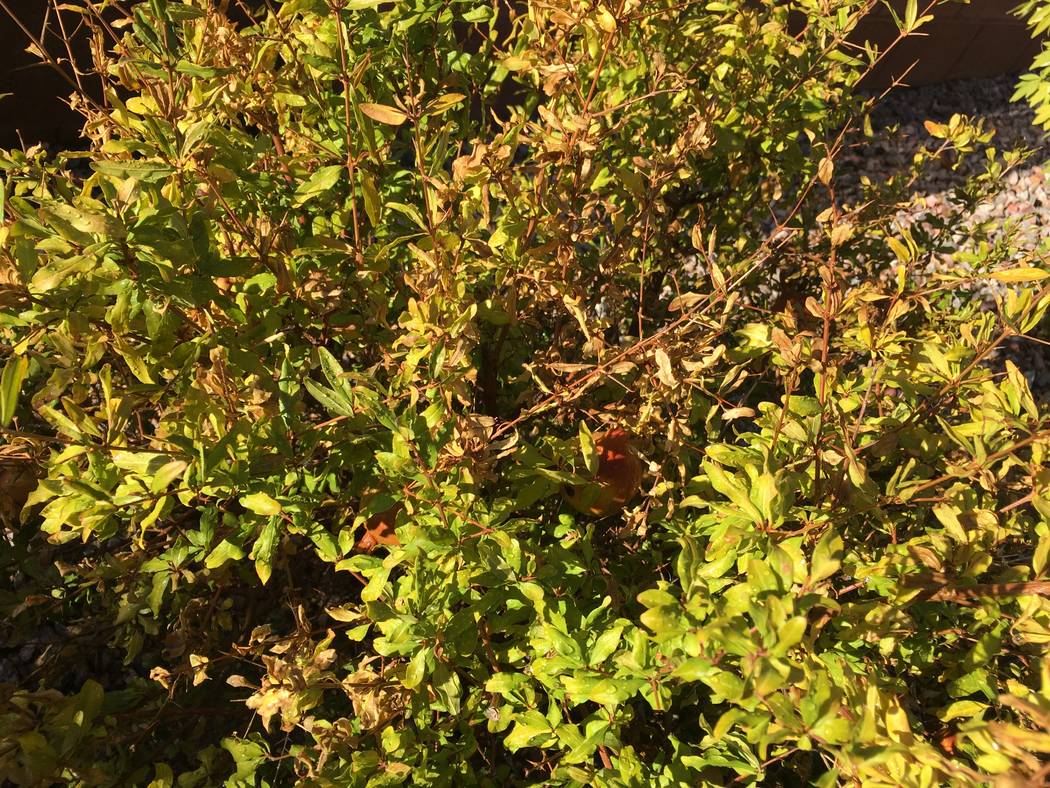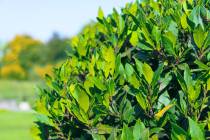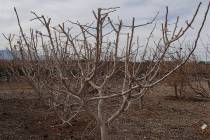Pomegranate resilient in desert, but watch overwatering
Q: A combination of overwatering and this heat caused my 9-year-old dwarf pomegranate leaves to yellow and drop on about a third of the plant. I turned off the water and hand watered it with small amounts of water. The only thing I did differently was to give the plants a small dose of Miracle-Gro in the spring. Any suggestions?
A: Pomegranate is remarkably resilient in our climate if it’s not watered too often. Avoid watering these plants daily. Give it plenty of water when you irrigate and then hold off until the next irrigation. They can handle some slightly dry soils. Water newly planted, spring trees every other day when temperatures are above 110 degrees.
Leaf yellowing and drop can be a temporary problem with many fruit trees and involve water issues. Give the plant time to respond if these branches are still supple and bend easily.
If these branches have dried and appeared dead, cut them off just above healthy growth. I have removed damaged parts during the summer months and the plant regrew without problems.
Use wood chip mulch on the soil surface to help preserve soil moisture during the heat. This gives the tree one extra day between waterings.
I am giving new plants about 5 gallons, 3-year-old trees about 10 gallons, 5-year-old trees about 15 gallons and trees older than 8 years old 20 to 30 gallons depending on their size. A dwarf 9-year-old tree is going to be in the range of 10 to 15 gallons each time you water.
I have had no problems with yellowing or loss of leaves during the summer, but some of the 20+ varieties I have grown experienced winter cold damage. Some varieties of pomegranates, particularly those with Russian names, showed some winter cold damage, but they recovered.
Older, more common varieties and sold for many years in the American market sailed through cold winters down to 10 F.
Q: My fiddle leaf fig houseplant has brown spots on some of the leaves. I’m watering it every other week. I thought it might be a fungal issue so I applied liquid copper, but that didn’t make any difference.
A: Fiddle leaf fig in the wild starts its life as an epiphyte, similar to orchids. Eventually, they root into tropical soils and live their life as a small understory tree, strangling the mother tree. This means it likes filtered and indirect light and can tolerate short periods of time surviving in dry soils.
Brown spots on leaves can be a disease problem, particularly if they are closely associated with leaf veins. Plant diseases on houseplants are not common in desert environments because of our low interior humidity.
Insects feeding on these plants are a bigger problem. Inspect the plant for spider mites, scale insects, mealy bugs and fungus gnats living in the soil. They can cause problems similar to diseases.
Plant diseases are closely associated with the health of the plant. To improve its health and ability to ward off diseases, make sure it gets adequate light, water and fertilizer. Staking this plant so it stands upright in a container indicates it has not been getting enough light in the past.
Lack of light is a common problem for houseplants because of our dark interiors. Larger houseplants slowly decline, beginning around six months after they are plunged into dark interiors.
Smaller plants decline more quickly. If they are large plants, they have enough stored food to live for several months before they decline.
This plant requires placement near a bright window but not in direct sunlight. Once a month turn the plant so that different sides of the plant receive light.
When temperatures are pleasant outside, place this tree in a sheltered area on the north or east side of the home under a tree. During this time, it can start building up food reserves for that long, dark haul inside the home during summer months. Never place it in direct sunlight, which damages the leaves and causes them to drop.
Don’t water on a schedule unless you are confident this schedule fits the needs of the plant. Water can be withheld until the soil is quite dry.
Instead, lift or tip the container to judge its water content. Water is heavy. Potting soil containing water is much heavier than dry soil.
Use a pencil. Sticking the pointed end of a pencil in the potting soil can help judge the moisture content. Pencils slide into moist soil much easier than dry soils.
Use a soil moisture meter. It costs about $10 at any nursery or garden center. They help judge relative amounts of water but not exact amounts of water. Soil moisture meters tell you if the soil is dry enough to water or if it’s still wet and should not be watered.
Avoid using straight tap water. Our tap water has lots of salts in it. Instead, use distilled or reverse osmosis water blended with tap water at least 1:1. Give it enough water so that one-quarter of the applied water comes out the bottom. This helps remove salts.
Add fertilizer based on the growth of the plant. If the plant is growing rapidly, temperatures are warm and there is plenty of light, water and fertilize more often. Add a small amount of fertilizer to the irrigation water every third or fourth watering.
Repot interior plants every three to four years. This means gently lifting the plant from its container and shaving off a 1- to 2-inch layer of soil from the root ball on all sides. Use a sharp, sanitized knife. Disinfect the container and repot the plant using new potting soil.
Q: We planted two magnolias in 2014. They are a few yards apart and receive the same treatment: some acid and a bit of iron once a year along with some fertilizer. One is thick and lush, with tons of beautiful blooms. The other is taller, less lush and its flowers sometimes get red markings on the tips. The red part is dry and rough in comparison to the soft and silky white part.
A: I have not seen this before on magnolia flowers in the Mojave Desert. First, let’s agree this tree is not supposed to grow here. That being said, there are a number of magnolias planted in Las Vegas, and some are doing quite well considering it is the desert. The best trees are protected from the wind, planted in lawns and located on the north or east sides of buildings.
I think you are seeing damage to the flower petals because of excessive drying of the tips. When magnolia flowers are damaged, the petals always turn a reddish-brown color. This damage could be because of high temperatures and high winds when the flowers were opening, petals were starting to get exposed, but still tight in the flower bud.
The location of this damage seems to be all on the tips of the petals, the parts exposed. I think you will see less of this when they are opening while temperatures are cooler and less wind when the flower buds are expanding. You might see less damage to flowers if there was less wind and the scrawny tree had more foliage.
Try vertical mulching around the scrawny tree. Vertical mulching is using a posthole digger to make vertical holes 18 to 24 inches from the trunk and about 2 feet deep. Backfill these holes with compost or a mixture of soil taken from the hole half and half with compost.
If they are surrounded by rock mulch, rake it back and put a 3- to 4-inch layer of woodchip mulch around the trees in a 6-foot diameter circle.
Fertilize the trees next January with compost mixed with iron instead of mineral fertilizer.
Bob Morris is a horticulture expert and professor emeritus for the University of Nevada, Las Vegas. Visit his blog at xtremehorticulture.blogspot.com. Send questions to Extremehort@aol.com.





























